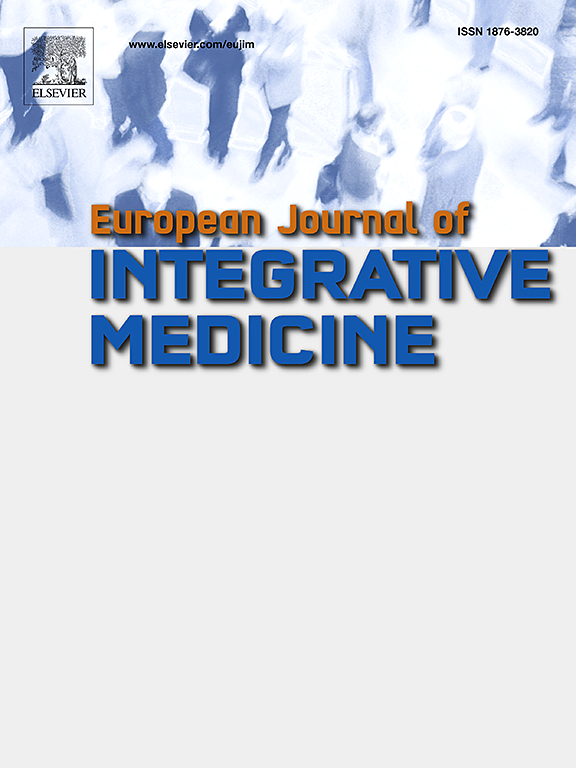The evolution of propolis research: A bibliometric analysis
IF 1.7
4区 医学
Q3 INTEGRATIVE & COMPLEMENTARY MEDICINE
引用次数: 0
Abstract
Introduction
Propolis is garnering increasing scientific and commercial interest due to its potential health benefits. Despite a surge in publications, a comprehensive overview of the propolis research landscape using bibliometric methods has been absent. This study aims to fill this gap by providing the first dedicated bibliometric analysis of global propolis research trends over the past two decades.
Methods
Data on propolis-related publications from 2004 to 2023 were retrieved from the Web of Science database. The R Bibliometrix package was employed to analyze publication trends, citation patterns, leading authors, institutions, countries, keyword co-occurrence, research themes, and collaboration networks.
Results
The analysis confirmed a substantial and consistent growth in propolis research. While publication volume is geographically concentrated (led by Brazil, China, Turkey), citation impact analysis revealed different patterns, with some countries (USA, Japan, Portugal, Bulgaria) demonstrating higher average citations per article, suggesting potential leadership in research quality or visibility. Thematic evolution mapping showed a clear trajectory from foundational studies focused on chemical composition and broad in vitro antioxidant/antimicrobial activity towards more sophisticated investigations into specific mechanisms (apoptosis, oxidative stress pathways), distinct propolis types (Brazilian green, stingless bee), and advanced applications (nanoparticles, nanofibers). Analysis identified central ‘’motor themes’’ (like chemical composition) requiring further development despite high interest, alongside highly developed ‘’niche themes’’ (like oxidative stress). Collaboration networks highlighted strong regional clusters but also opportunities for enhancing global integration, particularly bridging high-volume research hubs with high-impact centers.
Conclusion
This bibliometric analysis reveals propolis research as a dynamic, rapidly maturing, and increasingly interdisciplinary field. The divergence between publication quantity and citation impact, the clear evolution of research themes towards mechanistic depth, and the identification of specific developmental needs within the thematic structure offer critical strategic insights. The findings underscore a significant gap between the extensive preclinical investigation of biological activities of propolis and its translation into validated clinical applications. The findings advocate focused efforts on standardization, targeted international collaborations to leverage complementary strengths, and prioritizing clinical trials to substantiate the therapeutic potential suggested by the vast body of existing literature. This analysis provides an evidence-based roadmap to guide future research investments and collaborations effectively.
蜂胶研究的演变:文献计量学分析
蜂胶由于其潜在的健康益处而获得越来越多的科学和商业兴趣。尽管出版物激增,蜂胶研究景观使用文献计量学方法的全面概述一直缺席。本研究旨在填补这一空白,提供了第一个专门的文献计量分析全球蜂胶研究趋势在过去的二十年。方法从Web of Science数据库中检索2004 - 2023年蜂胶相关文献资料。使用R Bibliometrix软件包分析出版趋势、引文模式、主要作者、机构、国家、关键词共现、研究主题和合作网络。结果分析证实了蜂胶研究的实质性和持续性增长。虽然出版物数量在地理上集中(以巴西、中国、土耳其为首),但引用影响分析显示出不同的模式,一些国家(美国、日本、葡萄牙、保加利亚)的每篇文章的平均引用率更高,表明在研究质量或知名度方面可能处于领先地位。主题进化图谱显示了清晰的轨迹,从专注于化学成分和广泛的体外抗氧化/抗菌活性的基础研究,到更复杂的特定机制(细胞凋亡、氧化应激途径)、不同蜂胶类型(巴西绿蜂胶、无刺蜂)和高级应用(纳米颗粒、纳米纤维)的研究。分析确定了需要进一步开发的核心“运动主题”(如化学成分),尽管人们对此很感兴趣,以及高度发达的“利基主题”(如氧化应激)。合作网络突出了强大的区域集群,但也为加强全球一体化提供了机会,特别是将高容量研究中心与高影响力中心连接起来。结论文献计量学分析表明蜂胶研究是一个动态的、迅速成熟的、跨学科的研究领域。出版物数量和引用影响之间的差异,研究主题向机制深度的明确演变,以及主题结构中特定发展需求的确定提供了关键的战略见解。这些发现强调了蜂胶生物活性的广泛临床前研究与其转化为有效的临床应用之间的重大差距。研究结果主张集中精力进行标准化,有针对性的国际合作,以利用互补优势,并优先进行临床试验,以证实大量现有文献所建议的治疗潜力。该分析提供了一个基于证据的路线图,以有效地指导未来的研究投资和合作。
本文章由计算机程序翻译,如有差异,请以英文原文为准。
求助全文
约1分钟内获得全文
求助全文
来源期刊

European Journal of Integrative Medicine
INTEGRATIVE & COMPLEMENTARY MEDICINE-
CiteScore
4.70
自引率
4.00%
发文量
102
审稿时长
33 days
期刊介绍:
The European Journal of Integrative Medicine (EuJIM) considers manuscripts from a wide range of complementary and integrative health care disciplines, with a particular focus on whole systems approaches, public health, self management and traditional medical systems. The journal strives to connect conventional medicine and evidence based complementary medicine. We encourage submissions reporting research with relevance for integrative clinical practice and interprofessional education.
EuJIM aims to be of interest to both conventional and integrative audiences, including healthcare practitioners, researchers, health care organisations, educationalists, and all those who seek objective and critical information on integrative medicine. To achieve this aim EuJIM provides an innovative international and interdisciplinary platform linking researchers and clinicians.
The journal focuses primarily on original research articles including systematic reviews, randomized controlled trials, other clinical studies, qualitative, observational and epidemiological studies. In addition we welcome short reviews, opinion articles and contributions relating to health services and policy, health economics and psychology.
 求助内容:
求助内容: 应助结果提醒方式:
应助结果提醒方式:


